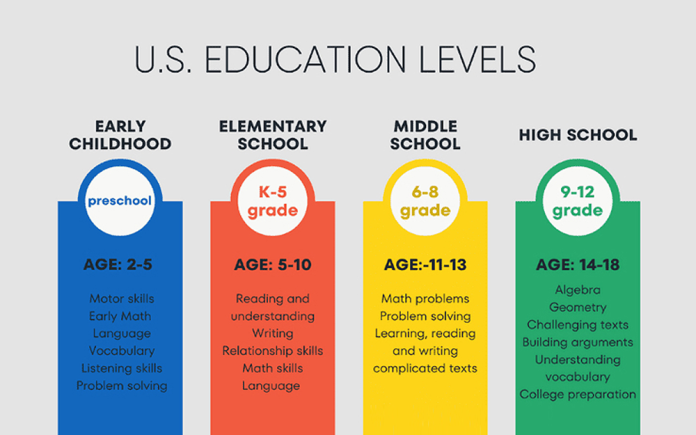
By Haddon Libby
Roughly 50 million American children are in Pre-K through 12th grade each year. About 70% of these students are in Pre-K through 8th with 30% in grades 9 through 12. Approximately 10% go to private schools with the rest attending public schools. These students are taught by roughly 3 million teachers for a 17:1 gearing ratio of students to teachers. Americans spend more than $700 billion each year through taxes or tuition or $14,000 annually on each student.
At the end of the last school season, 5.85 million students were in the California School System attending one of the states’ 10,000 schools. There were 2.6 million students in kindergarten through 5th grade, 1.3 million in grades 6 through 9 and 1.9 million in grades 9 through 12. The largest ethnic group was Hispanic representing 56% of students followed by non-Hispanic whites at 20%, Asian with 9.5% and African Americans at 4.7%. These students were taught by roughly 320 thousand teachers for a gearing ratio of 18:1.
To those who know how impressive the California Public School System once was, it is hard not to think that the learning at many K-12 public schools, at least in the Coachella Valley, is less than it once was. There are many reasons that California’s public education system is less than it once was. At the core, the biggest issue is that a large percentage of parents are not involved in the education of their children. A general review of the best schools in our state versus the worst schools typically relates to the parent’s involvement in the promotion and support of a culture of learning.
For all the complaints that any of us may have with the California school system, US News and World Reports agrees and finds that our state ranks 38th out of the 50 states in K-12 education. When we look at our local Coachella Valley schools, we are in the bottom half of the state school rankings. This means that a public education in the public schools in the Coachella Valley is most likely in the bottom quintile on the United States.
For those of us who have students in our school system, we should be raising bloody hell. This is a wholly unacceptable level of education for our children. They deserve a better chance at success than what we seem to be able to derive from what is currently offered.
So which states have a quality K-12 educational system?
According to US News & World Report, New Jersey is the best place to receive a K-12 education. Standardized testing has the state toward the top in math, reading and writing. The five schools of Milburn graduate 99% of seniors.
Looking at some of the valley’s middle school rankings, Palm Desert Charter Middle School ranks above average with english scores at 60% but lags with math and science at 36% and 37%, respectively. If we head west to Raymond Cree Middle School, english scores fall to 40% with 25% for match and 16% for science. If we head east to La Quinta Middle School, english scores are 38% with math at 24% and science at 19%.
Massachusetts comes in second to New Jersey with K-12 education followed by Connecticut, Vermont, Illinois, New Hampshire, Indiana, New York, Utah and Wisconsin.
The state to avoid if you have K-12 children is New Mexico followed by Oklahoma, Arizona, Alaska and Nevada.
None of this is to say that you cannot find a good or bad school in a good or bad school district or state. What this does say is that parents have to be far more selective and involved in the education of their children when using the public services of underperforming states and school districts.










































